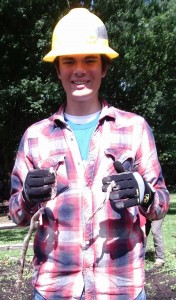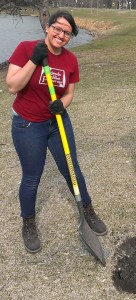As the Forest Preserve District of Cook County celebrates the century mark of the law that paved the way for its creation, officials and local conservationists are trying to reclaim the land from alien plants that have flourished amid years of financial and environmental mismanagement.
Even some of the district’s harshest critics are encouraged by progress at the district, the first of its kind in the nation.
Environmental groups that once issued scathing reports on mismanagement of the county’s 106-plus square miles of land say the district is moving away from the bureaucratic ambivalence of the past as it tackles aggressive plants that have spread through tens of thousands of acres of woodlands and prairies.
More than two-thirds of the more than 68,000 acres the district has assembled over the last 100 years are overrun with non-native flora, said longtime conservation activist Stephen Packard, who led one of the first efforts to beat back invasive intruders in 1977.
“I have great optimism,” said Packard, who notes that the district has restored only a few thousand acres over the past 30 years. “There is no reason we couldn’t have 30,000 acres” — an area roughly 10 times the size of Oak Park — “restored in the next 20 years.”
After much debate, a bill was signed in June 1913 that authorized forming the forest preserve district, which held its first meeting two years later.
The taxpayer-funded agency was charged with acquiring and preserving natural areas threatened by a fast-expanding Chicago and its suburbs.
Starting with a 500-acre plot in Palatine now known as the Deer Grove Forest Preserve and acquired in June 1916, the district owns about 10 percent of the total area of Cook County. Its annual budget is $189 million, and the district employs about 600 people.
According to dozens of news reports over the years, the district was long regarded as a place where patronage workers were sent to get lost in the woods. At other times the preserves were more notable for piles of fetid trash overflowing from garbage bins than for their ability to connect residents with plants and animals.
Moreover, critical management — such as brush removal and controlled burns — was put off for years because of political concerns. For example, in 1996, restoration opponents persuaded then-County Board President John Stroger to impose a moratorium on such projects in the entire district.
The moratorium was slowly lifted, but conservationists complained that while it was in place, invasive plants quickly reclaimed areas that had been painstakingly cleared.
The district has been slow, critics say, to react with a comprehensive plan to combat the invaders. The district will release a plan for all 68,000 acres this fall, said Arnold Randall, the district’s general superintendent, who was appointed in 2010.
Randall acknowledges the restoration work is a massive undertaking but said a comprehensive road map will make it easier to tap outside money from other agencies and donors.
“I don’t know why it didn’t happen decades ago, but if you look at the restoration activities, that was a grass-roots movement that started in the ’70s and ’80s,” he said. “And there were still people, into the ’90s, that were really opposed to what (the district) was doing.”
Observers say the district’s turnaround began after a financial crisis in the early 2000s when it was $16 million in debt. Staff was cut in half, and budgets were slashed or frozen. The agency slowly began to refocus on its core mission of preserving native habitat.
“I think that clearly the finances are in better shape, and we have a more efficient workforce,” said Cook County Commissioner Larry Suffredin, D-Evanston, a frequent critic of waste and incompetence at the district.
Indeed, the credit rating agency Standard & Poor’s boosted the district’s score last year from AA- to AA, citing management improvements and staffing cuts that date back to the 2003 reorganization. And in February, the district was released from a monitoring program required as an anti-patronage safeguard under the federal Shakman decrees.
Suffredin and others admit much remains to be done after years of neglect and mismanagement gave unwanted plants a head start.
To the untrained eye, the thickets of buckthorn or a field carpeted with purple loosestrife might look lush or even lovely. Yet those plants, imported from Europe in the 1800s, are upsetting the natural order, forest preserve ecologist Chip O’Leary said.
Brought in as a hardy hedge plant, buckthorn has spread across nearly every state in the northern half of the U.S. It is among the first to produce leaves in the spring, blocking the sun from reaching grasses, flowers and native tree seedlings.
Compounding the problem, buckthorn berries have a laxative effect on birds, ensuring that the seeds spread prolifically. Once the plant has taken over an area, little remains for insects, birds and animals to eat, leaving the woods eerily quiet.
“It’s kind of like a desert,” O’Leary said. “You kind of lose a lot of your natural experience — the bees buzzing and the birds chirping and flying around.”
Loosestrife similarly crowds out other native wildflowers, and each plant can produce millions of seeds a year. It also forms dense tangles around ponds and marsh areas, and can literally suck them dry.
Joining these pests are garlic mustard, multiflora rose, ailanthus and barberry.
Clearing them out is expensive and time-consuming and often must be repeated for several years to combat regrowth, said Chris Evans, an invasive species expert working with the Illinois Department of Natural Resources.
“I’ve seen some of these really infested areas cost $1,500 to $2,000 an acre to clear, and that’s just for the initial treatment, just for removal and herbicide,” Evans said.
Facing such heavy costs, forest preserves often have to prioritize and focus on high-quality areas or significant areas of risk, he said.
For decades, with the district focused on accumulating new land, little thought was given to maintaining or improving what it had. That began to change in the 1990s, officials said.
“When you think of the name, it’s the ‘forest preserve,’ so people thought that preserving land was what it was about,” Suffredin said.
But it wasn’t enough merely to curtail development on forest preserve property or “let nature take its course,” he said.
Gradually, with a better understanding of the land’s ecology, officials realized the importance of going after the invaders.
Twenty years ago, any restoration work was largely accomplished by volunteers and by the staff at a particular preserve.
Even when officials tried to ramp up their efforts, they were often stymied by those who feared their woods were being chopped down.
“In the early ’90s, we hired our first land manager and got our first grant from the U.S. Forest Service for our staff to restore Swallow Cliff Woods,” district spokeswoman Karen Vaughan said, referring to a tract near southwest suburban Palos Park.
Over the last five years the district has devoted more than $12 million to habitat restoration and has set aside $5 million for such efforts this year, Vaughan said.
It also has increased the number of trained volunteers who help district staff marshal the efforts of others who want to help.
On Thursday, Matthew Yanz and three other volunteers with the Chicago Audubon Society trudged through a section of Willow Springs Woods near southwest suburban Willow Springs. Every few feet they stopped to spray herbicide on new growth from the stumps of buckthorn and honeysuckle plants cut down last year.
Yanz’s supervisor, Eric Menigat, said four similar teams are at work every day from 7 a.m. to 3 p.m., clearing brush and weeds or trying to maintain areas. Larger projects involve contractors hired by the district. The workload is growing as more and more acres are stripped of unwanted plants, he said.
“The work is kind of daunting,” Yanz said. “But then, you get going.”
Volunteers sometimes get an earful from people who don’t understand what they’re doing, said Jerry Stoeckigt, executive director of Chicago Area Mountain Bikers, or CAMBr. His group is heavily involved in developing and maintaining legal off-road biking trails in the district. Its volunteers often help with removing buckthorn and other unwanted plants.
“What we see when we start clearing a place out is that people start complaining about how we’re ruining their beautiful woods,” he said.
Suffredin acknowledges the public relations issues and the long road the district still faces before it begins to win the invasive species battle.
“When you have 68,000 acres, you’re not always turning the corner on all of them,” he said. “But I think that we have done more than we had been doing.”







